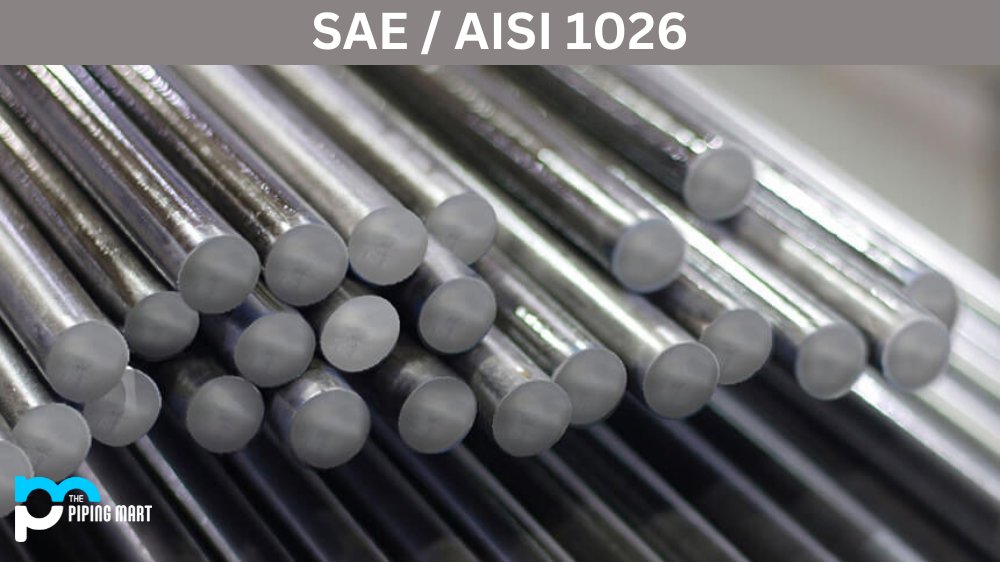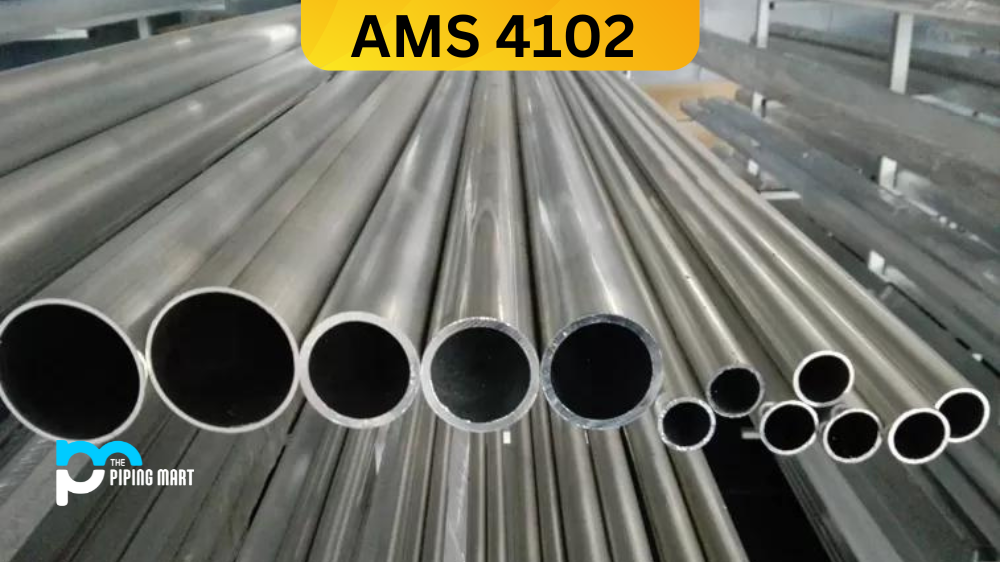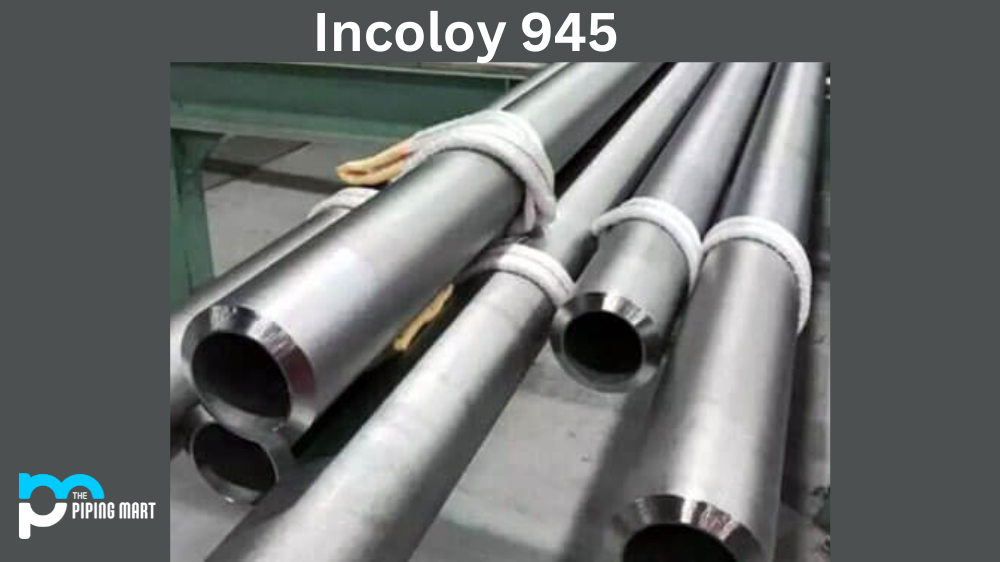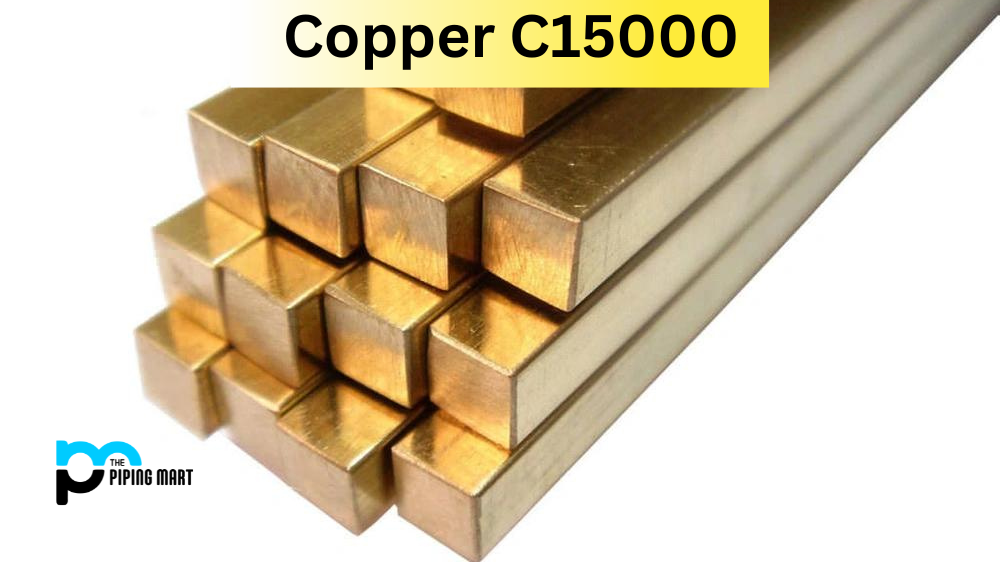SAE 1026 is an alloy steel that is composed of carbon, manganese, phosphorus, sulfur, silicon, and nickel. It is a versatile material used in the manufacturing of a variety of components where strength and wear resistance are required. This blog post will cover the composition, chemical properties, mechanical properties, physical properties, uses, corrosion resistance, heat resistance, heat treatment options and machining and welding processes associated with SAE/AISI 1026.
AISI 1026 Composition
The composition of SAE 1026 includes 0.22-0.28% Carbon; 0.60-0.90% Manganese; 0.04% (Max) Phosphorus; 0.05% (Max) Sulphur; 0.15-0.30% Silicon; and 0.40-0.75 Nickel (Ni).
| Element | Content (%) |
|---|---|
| Iron, Fe | 98.73-99.18 |
| Carbon, C | 0.220-0.280 |
| Manganese, Mn | 0.60-0.90 |
| Sulfur, S | ≤ 0.050 |
| Phosphorous, P | ≤ 0.040 |
AISI 1026 Chemical Properties
The chemical properties of SAE 1026 include high levels of strength and ductility due to its low level of carbon content as well as its ability to be hardened through tempering or quenching processes without the risk of cracking or warping the material’s structure due to its low levels of phosphorus and sulphur which reduce brittleness within the alloy steel type’s structure when heated or cooled after hardening treatments have been applied on it.
AISI 1026 Mechanical Properties
The mechanical properties associated with AISI 1026 include higher levels of tensile strength than many other alloy steels because it has a lower percentage of carbon content than many other alloy steels which reduces the amount of stress placed upon it when under pressure or tension making it ideal for use in applications such as automotive parts creation where high levels of strength are required but not at the cost of material failure due to overstressed parts caused by too much carbon in the alloy steel blend itself.
| Properties | Metric | Imperial |
|---|---|---|
| Tensile strength | 490 MPa | 71100 psi |
| Yield strength | 415 MPa | 60200 psi |
| Bulk modulus (typical for steel) | 140 GPa | 20300 ksi |
| Shear modulus (typical for steel) | 80.0 GPa | 11600 ksi |
| Elastic modulus | 190-210 GPa | 27557-30458 ksi |
| Poisson’s ratio | 0.27-0.30 | 0.27-0.30 |
| Elongation at break (In 50 mm) | 15.00% | 15.00% |
| Reduction of area | 40.00% | 40.00% |
| Hardness, Brinell | 143 | 143 |
| Hardness, Knoop (converted from Brinell hardness) | 163 | 163 |
| Hardness, Rockwell B (converted from Brinell hardness) | 78 | 78 |
| Hardness, Vickers (converted from Brinell hardness) | 149 | 149 |
| Machinability (based on AISI 1212 steel as 100 machinability. The machinability of Group I bar, rod, and wire products can be improved by cold drawing.) | 75 | 75 |
AISI 1026 Physical Properties
Alloy 1026 is a widely used low-carbon alloy steel with excellent chemical and physical properties. It is highly ductile, strong and reasonably easy to weld, making it an ideal material for complex industrial applications. With up to 0.30% carbon content, it offers good formability but with certain limitations and requires adequate preheating before welding or machining. Its strength-to-weight ratio makes it an efficient choice for automotive components and other demanding engineering assemblies. It also excels in toughness at low temperatures. It maintains useful mechanical properties after hardening in the low-temperature range, making it an invaluable resource for many industries worldwide.
| Properties | Metric | Imperial |
|---|---|---|
| Density | 7.858 g/ cm3 | 0.2839 lb/in³ |
AISI 1026 Thermal Properties
| Properties | Metric | Imperial |
|---|---|---|
| Thermal expansion co-efficient (@0.000-100°C/32-212°F) | 12.1 µm/m°C | 6.72 µin/in°F |
| Thermal conductivity (0ºC) | 51.9 W/mK | 360 BTU in/hr.ft².°F |
AISI 1026 Equivalent
| ASTM A29 | ASTM A510 | ASTM A512 | ASTM A513 | ASTM A519 |
| ASTM A545 | ASTM A576 | ASTM A830 | MIL F-20670 | MIL S-22698 |
| MIL S-24093 | SAE J1397 | SAE J403 | SAE J412 | SAE J414 |
| ASTM A273 |
AISI 1026 Uses
Grade 1026 is a steel grade with excellent properties for making mechanical parts. Its high ductility and low hardenability make it an ideal choice for producing components that require tight tolerance levels and need to withstand rotating forces and impacts. It can be used to construct tight-tolerance bearing systems, as well as delicate small parts such as fasteners. Moreover, with its balanced composition of carbon, manganese and u-saccharide chromium, SAE / AISI 1026 has very little susceptibility to quench cracking or other forms of failure under high temperature conditions. Therefore, it is often used in the construction of heat exchangers, valves and other heat transferring machines.
Corrosion Resistance
SAE 1026 carbon steel is a popular carbon steel that is highly valued for its corrosion resistance capabilities. It has been an essential material in many industries due to its strong protection against liquids and gases, making it great for applications such as chemical processing, oil and gas production, marine environments and food production. With its high chromium content, SAE/AISI 1026 offers excellent oxidation and carburization resistance over a wide range of concentrations and temperatures. Additionally, it features good atmospheric corrosion resistance which can protect the steel from micro-organisms that corrode surfaces in certain environmental conditions. Its robustness allows SAE/AISI 1026 to resist various corrosive environments while also keeping shape during deformation processes. Thanks to its efficient level of protection against corrosive substances, this steel offers increased performance and longevity in numerous applications.
Heat Resistance
Heat resistance is an important property of SAE/AISI 1026, which is a carbon steel material grade primarily used in the automotive industry for structural applications and other where higher mechanical properties are essential. With a max hardness of 260-320 HB, it possesses strong heat resistance that resist degradation caused by high temperatures, making it ideal for use in components exposed to high temperatures or engine wear. Its ability to maintain its strength and ductility even at elevated temperatures makes it a dependable choice for automobile designs that demand a lot from their materials. It’s also worth noting that SAE/AISI 1026 has a good weldability rating; this combined with its outstanding heat resistance makes it an excellent all-around material for automotive parts.
Heat Treatment
Heat treatment of 1026 carbon steel is an important process to consider when working with this versatile steel. It increases the strength, hardness and corrosion resistance of the metal significantly. Heat treatment involves heating the material to a specific temperature for a particular duration, followed by cooling it according to a set pattern. This process also helps remove residual stress in the metal, as well as improves its machinability and weldability. AISI 1026 steel is typically heat-treated at a temperature range of 1010 degrees Celsius up to 1050 degrees Celsius, depending on its intended use. Adhering to these temperatures is essential for producing optimal results from the heat treatment process.
Machining
Machining SAE/AISI 1026 steel is not as demanding as it may seem. Though this alloy is considered to be an “easy-to-work” steel grade, caution should be taken when machining due to its weldability and carbon content. This particular steel grade has good cold forming characteristics, so best results come from punching, shearing and rollforming. Coolant lubricants are recommended for SAE/AISI 1026 machining projects due to the carbon content; but cutting speeds and feed rates should still remain conservative to ensure a smooth finish on the final product. With proper care and consideration for the nature of this alloy, any machinist can craft a lasting part out of SAE/AISI 1026 steel.
Welding
Welding SAE/AISI 1026 steel is a great choice for general engineering and structural applications. This material has excellent weldability characteristics with its carbon content of 0.22-0.28%. This low-carbon steel can also be heat treated to increase its hardness and strength, as well as improve its machinability. With a tensile strength range of 470-620 MPa, this material is very strong yet ductile enough to be formed into different shapes when welding. As an added bonus, SAE/AISI 1026 Welding produces an aesthetically pleasing finish that can either be sanded or painted over. Just like with any other welding project, it’s important to use the right type of electrodes and choose the most suitable joint configuration when dealing with SAE/AISI 1026 welding in order to get the desired results.
Conclusion
SAE/AISI 1026 is an alloy steel type that offers excellent mechanical properties such as high levels of tensile strength and ductility due to its low carbon content coupled with its ability to be hardened through tempers or quenches without risking cracking or warping from too much phosphorus or sulphur within its structural makeup when heated or cooled after hardening treatments have been applied on it also makes this type an ideal choice for those looking for strong yet durable component parts perfect for their application needs whether they require corrosion resistant parts that can withstand environmental conditions better than traditional alloys or heat resistant pieces that can stand up against higher temperatures without suffering any damage during their operation periods without sacrificing their structural integrity either way this alloy steel type offers something for everyone no matter what their needs may be when it comes to component part creation out there in industry today so if you’re looking for something reliable long lasting and strong then look no further than SAE/AISI 1026!

Meet Bhavesh, a seasoned blogger with a wealth of knowledge and experience. From metal products manufacturing to retail, Bhavesh has a diverse background in various industries and is dedicated to sharing his insights and expertise with readers.




